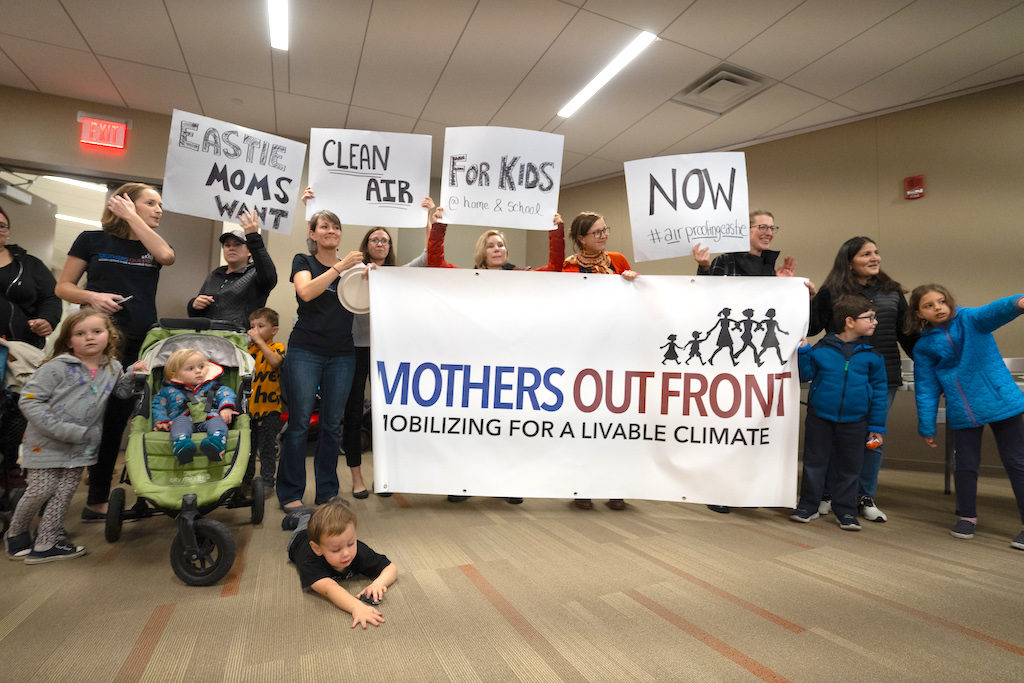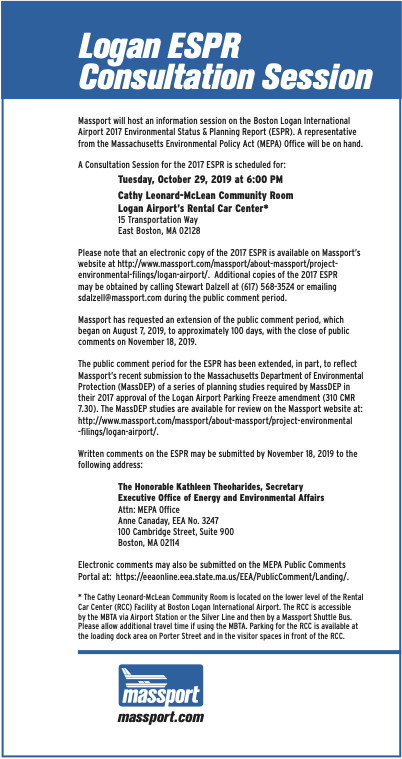Massport Defends Environmental Filing
Published on
East Boston, MA — On Tuesday evening Massport held a Logan ESPR Consultation Session to inform the community about their recent MEPA filings, answer questions and take comments. Stewart Dalzell, Deputy Director of Environmental Planning and Permitting, began the night with an overview presentation lasting 40-minutes, which paused for a statement by State Representative Adrian Madaro. Then the trio of Dalzell, Director Aviation Planning and Strategy Flavio Leo and Deputy Director of Community Relations Anthony Guerriero, answered questions from the community and defended their most recent filing, the 2017 Environmental Status and Planning Report (ESPR,) which is available for download here.
(Update 2019-11-06 The slides are now posted for download here.)
The Mothers Out Front of East Boston were also present, demonstrating over the health impacts for children in the neighborhood. Group leaders Julia Burrel and Sonja Tengblad followed up with Facebook statements.

AIR Inc. representative Chris Marchi lived streamed the event on Facebook, the archive of which is available here.
After the presentation, the discussion began.
When pressed on the Airport growth forecast, Leo shrugged it off saying that they both under- and over-shoot, and defended the low growth rate by claiming the country’s economic expansion was unprecedented and that Airport growth was correlated to economic growth, insinuating that his low forecast was backed by data and sound bets.
Later, Leo was asked about the addition of flight restrictions, which he deferred on, instead blaming federal regulation for why Massport can’t do what the community wants. He continued that peak pricing is ineffective for affecting flight restrictions because flight volume is down from historic highs, so there isn’t enough demand to trigger it.
Leo also stated they use FAA models for air and noise, not actual sensor data, citing FAA best practices, and added the no ultrafine particle standards exist.
On noise, Leo stated that Massport is required to report day-night average sound level (DNL) despite that “not being how people experience noise” and that populations affected by noise are a function of noise contours correlated to Census block data.
Dalzell said that Rep. Madaro’s comments would need to be addressed through the MEPA process for the next ESPR.
Public comment may be submitted via the following link: https://liveeastboston.com/public/ESPR-2017/
Rep. Madaro’s Remarks
“I come before you to discuss the 2017 ESPR and share my thoughts on the discrepancy between the stated projections and the current reality and what this means for us here is East Boston.
First thing I want to address is passenger increases and I want to express my concern over the projected rates passenger and airport growth contained in the ESPR. Passenger growth is forecast at 1.5 percent and aircraft at 1.2 percent for the 2017 ESPR. This appears to be an implausibly low estimate. Over the past 5 years passenger growth averaged 6.5 percent and aircraft 5.9. The 2011 ESPR suggested airport passenger volumes would reach roughly 33 Million by 2019 but we are on pace to surpass 43 Million passengers by 2019. Logan has grown from 25 Million passengers per year in the mid nineties to 43 Million a year this past year, which is an additional 18 Million passengers representing a 72 percent increase. That is not what was presented to the community and certainly far exceeded our expectations.
Now to discuss noise. Estimates show that population exposed to 65 DNL or higher which are residents impacted by the worst airport noise across the region have doubled. All of this increase has occurred right here in my district in East Boston with totals rising a staggering 1400 percent as reported a 2017 ESPR. The 2017 ESPR reports nighttime operations which may cause health impairments associated with sleep interruption, hypertension and some other neurological disorders have increased by 43 percent over the past 6 years. Many European airports such as Heathrow and London and most major German airports have night time flying restrictions. Massport should consider implementing similar nighttime operation restrictions which would greatly benefit residents in around those communities and East Boston.
Now I want to address pollution and traffic. 2017 ESPR data shows that NOX which is a key predictor respiratory illness has increased by 46 percent over the past 5 years. Average weekday traffic has grown by over 21 percent since the last ESPR. A substantial portion of this traffic has been due to an explosion of TNCs here at Logan airport. These have diverted people from public transport into millions of rides.
Now I want to pause and give credit to Massport on this for the recent changes to TNC pick up and drop off which are implemented at Logan this past week as well as other efforts specifically to increase Logan Express which will which will help reduce traffic in our area. But the ESPR should also include an analysis of this traffic, where this traffic is going, and how more public transit mitigation for enhanced Logan Express, fluid Silver Line service and in investments improvements such as the Red-Blue Connector could offset this congestion in traffic. Traffic growth causes congestion and jams clogging our tunnels and backing traffic up into the neighborhood streets of East Boston. This traffic which Logan contributes to significantly causes quality of life, economic and health issues for East Boston residents. People are now routinely late to work, school appointments and stuck in congestions, dealing with the fumes of particulates from traffic on residential streets.
Now I want to discuss mitigation. Many of the impacts is seen in our community have been significantly under estimated. Going by your old forecasts we should not be where we are today. The numbers we are seeing would have put us in the 2040s based on Massport’s previous estimates. A direct consequence of this chronic underestimation is the failure to provide adequate solutions in appropriate mitigation to deal with increased impacts. Sometimes the modeling gets it wrong. This is a reality. However when various models are consistently underestimating impacts by a significant margin–whether this speaks to passenger estimates, traffic estimates, noise, fume and particulate estimates–this becomes a serious issue. Modeling that systematically underestimated leave us systematically under prepared to deal with the impacts. Neighboring communities are saddled with unfair burdens and insufficient mitigation. This level of airport growth and environmental degradation speaks to a need for an enhanced level of response and mitigation from that offered to the 2017 ESPR. Mitigation based on projections that fall short of reality that similarly falling short of providing the necessary offset for our community. Projects such as air proofing for our public schools like what’s seen today in Seattle can help to ameliorate the effects of the past 10 years of expansion.
This meeting needs to provide for discussion and comments of the MEPA and Massport ESPR 2013 effectiveness of present impacts and to what extent the policy and mitigation provided has addressed the present level of unanticipated airport growth.
We can and must do better for the residents of East Boston. My constituents deserve a high quality of life and deserve to have airport impacts adequately mitigated. I look forward to continued dialogue on this issue with Massport, members of the community and everyone here tonight. Thank you so much for your time.
State. Rep Adrian Madaro
Event Stream by Chris Marchi
Massport Flyer
